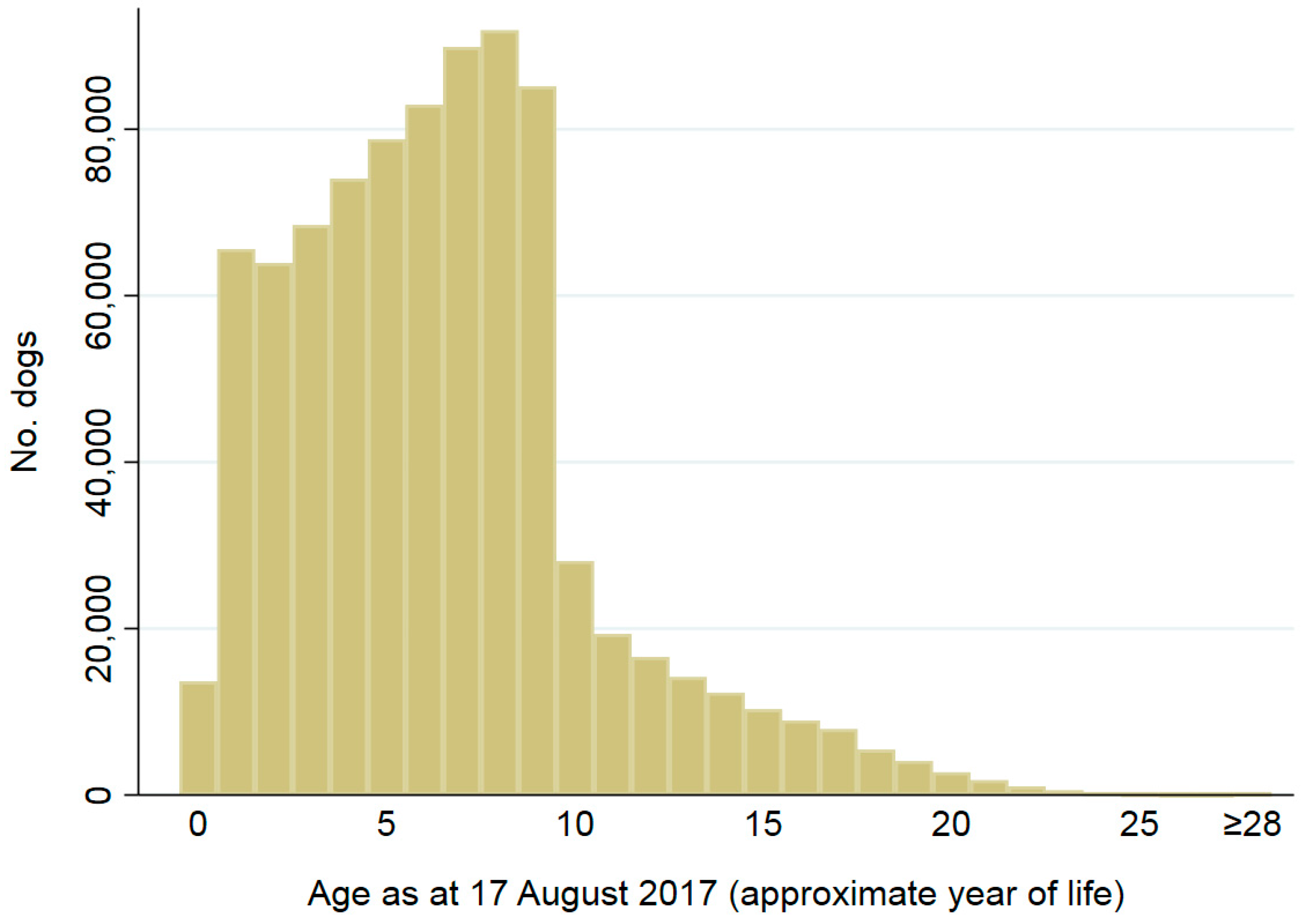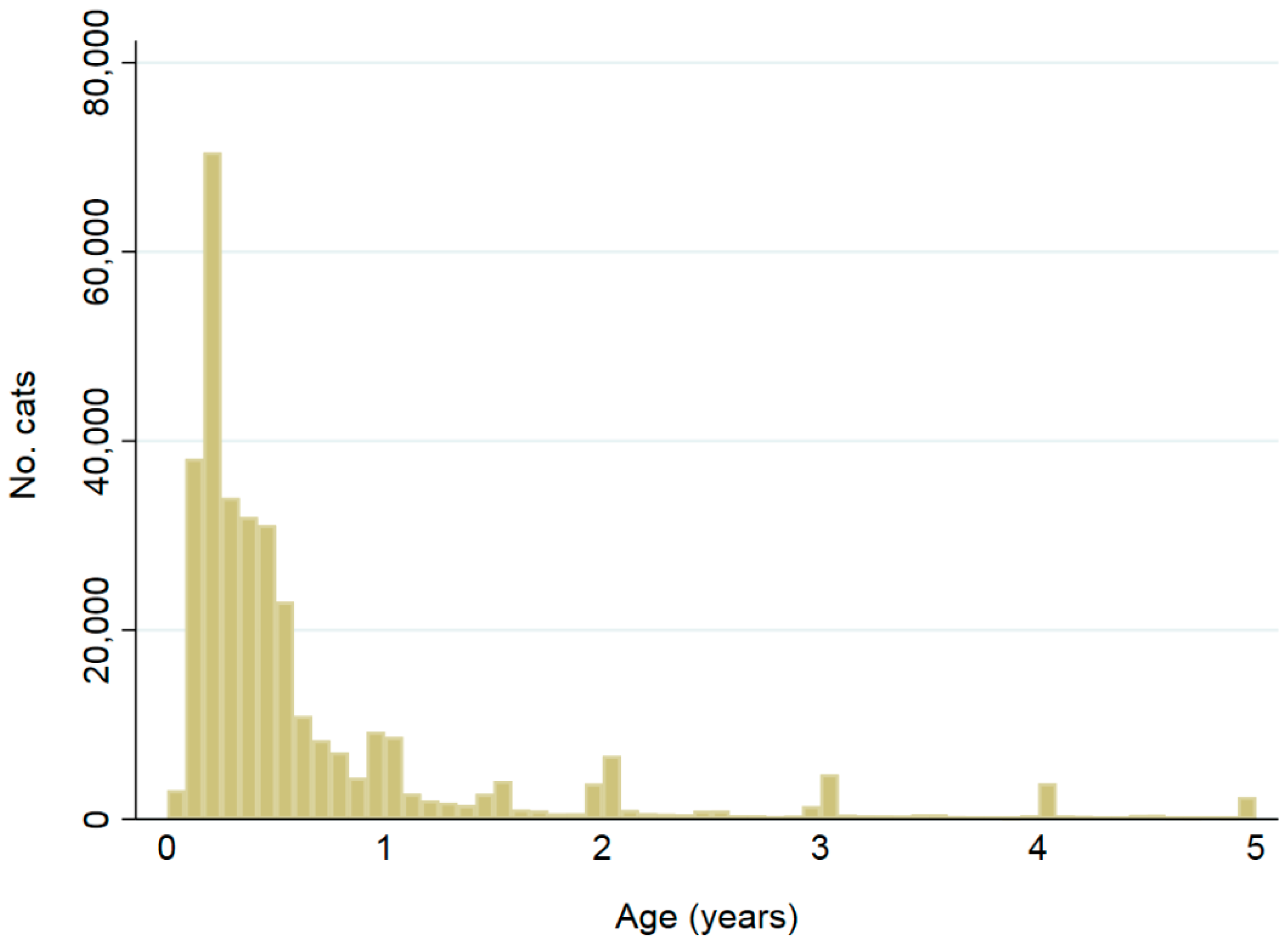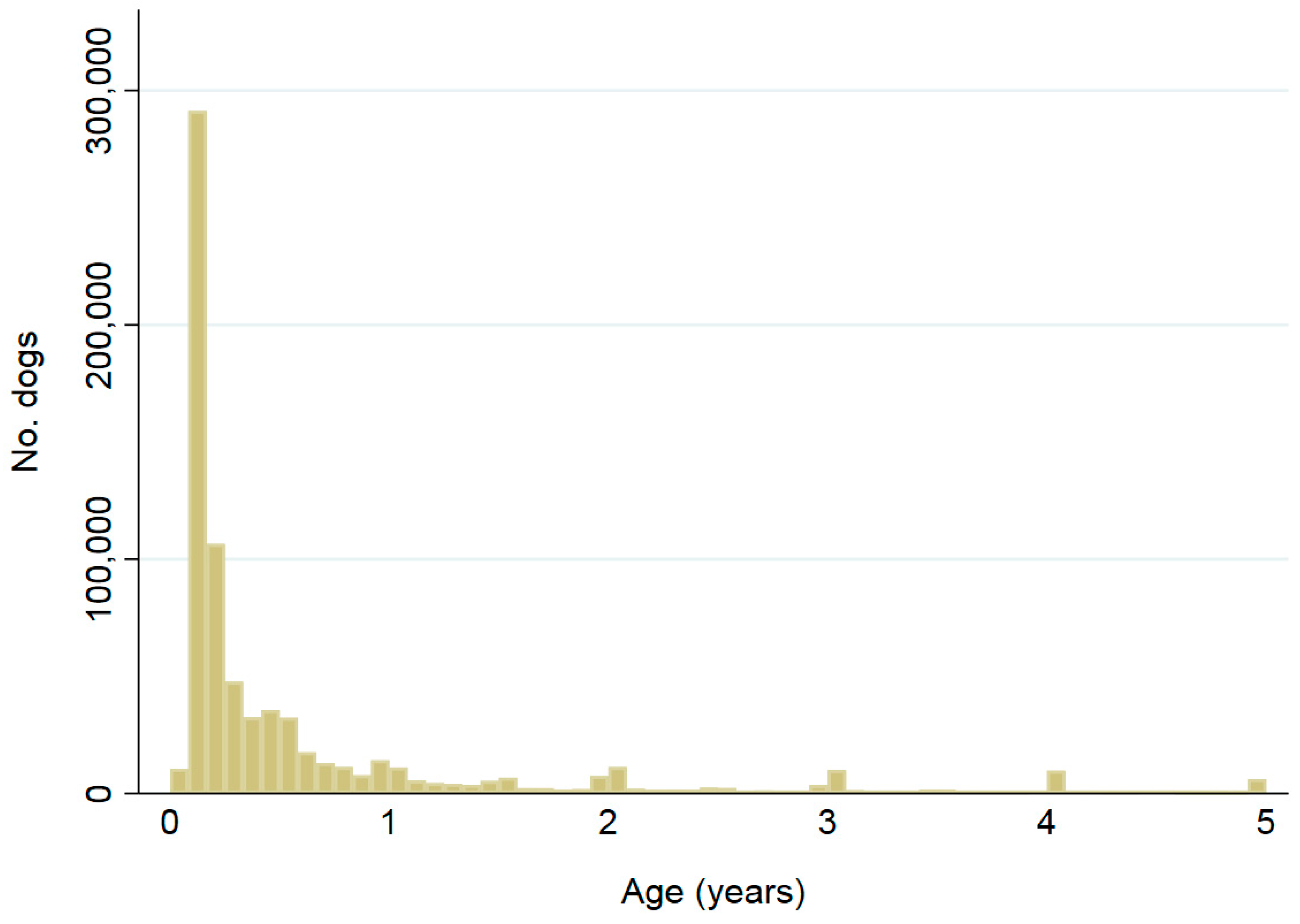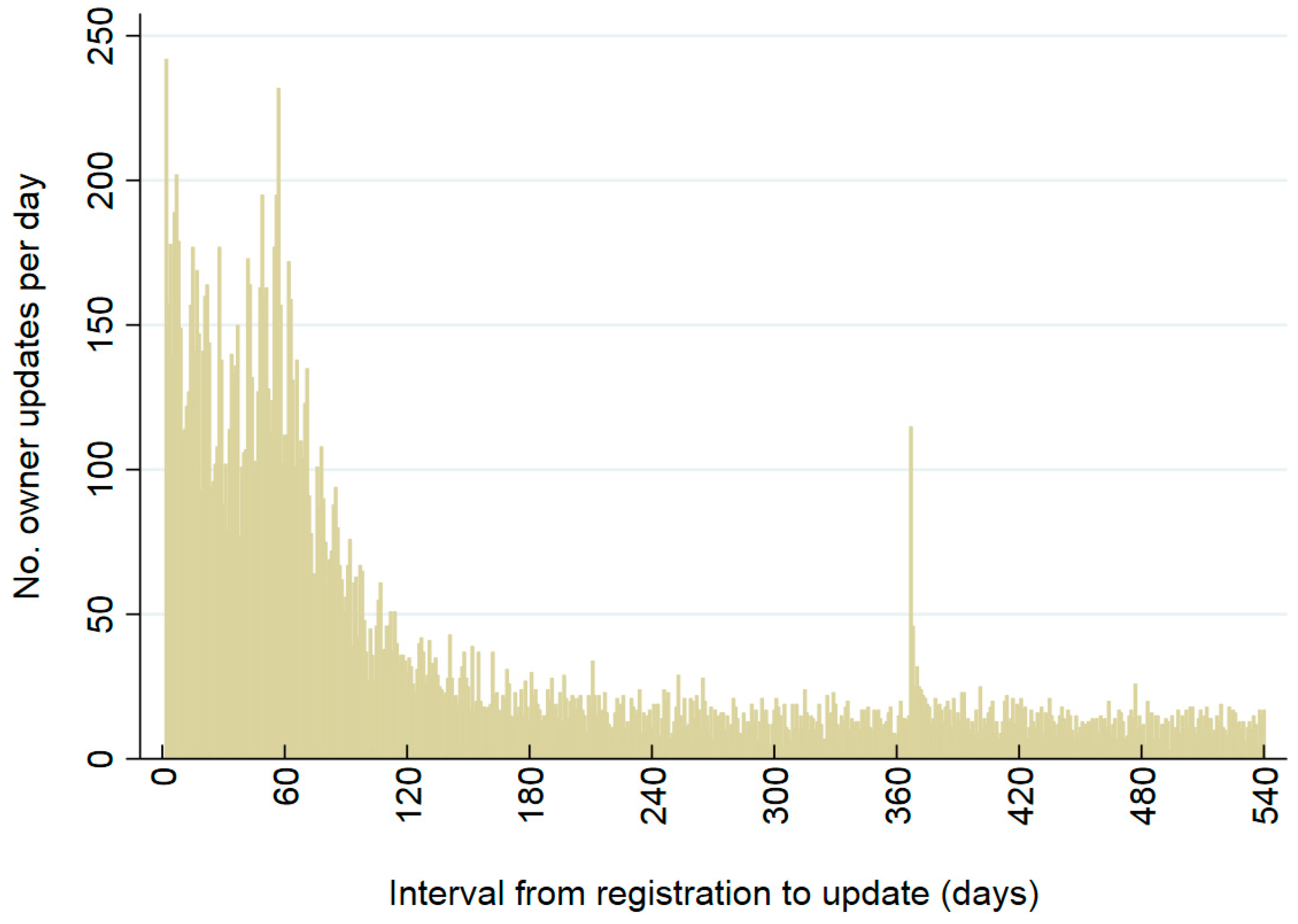1. Introduction
Australia has one of the highest rates of pet ownership worldwide, with an estimated 3.3 million cats and 4.2 million dogs belonging to 63% of Australian households [
1]. In the United States (US), 44% of households own a cat or dog [
2], and approximately 50% of United Kingdom (UK) households have a cat or dog [
3]. Such high pet ownership rates in Western countries are associated with a substantial number of stray animals admitted to shelters and pounds each year. In 2015–2016, 45,256 dogs and 55,570 cats were presented to the Royal Society for the Prevention of Cruelty to Animals (RSPCA) in Australia [
4], an estimated 6.5 million cats and dogs were received by the American Society for the Prevention of Cruelty to Animals (ASPCA) in the US [
2], and the RSPCA UK received 129,602 cats and dogs [
3]. Strays admitted via the general public and municipal contracts accounted for approximately 60% of all dog and cat admissions to RSPCA shelters in Australia [
5,
6], 26% of dogs and 42% of cats admitted to UK animal rescue organizations during 2010 [
7], approximately 40–60% of animal intakes to shelters in the US [
8], and 68% of cats and dogs admitted to shelters in Spain [
9].
Stray pets that are not reunited with owners are at risk of euthanasia. In 2015–2016, 39% of dogs and 5% of cats admitted to the RSPCA Australia were successfully reunited with owners (‘reclaimed’), and 21% of unclaimed dogs and 30% of unclaimed cats were euthanized [
4]. Nationally, 48% of all admitted dogs from Australian municipal councils, animal welfare organizations and rescue groups were reclaimed and 21% were euthanized (40% of unclaimed dogs) in the 2012–2013 financial year [
10]. In ASPCA shelters, approximately 18% of stray dogs and 3% of stray cats were reclaimed while 23% of cats and dogs were euthanized in 2015–2016 [
2]. In Spanish shelters, 17% of dogs and 4% of cats were reclaimed while 13% of dogs and 23% of cats were euthanized [
9].
Currently, in all Australian states and territories except the Northern Territory (NT) and South Australia (SA), it is mandated that dogs and cats must be microchipped at the time of registration with local government (council) or transfer of ownership (
Table S1) [
11,
12,
13,
14,
15,
16,
17,
18,
19,
20]. It was estimated that 76% of Australian dogs and 64% of owned cats were microchipped in 2013 [
1]. The act of implanting pet microchips is highly regulated, and animal and owner information and contact details must be provided to a licensed registry within a specified time following implantation. However, it is the responsibility of the owner to ensure pet and owner details (including owner contact details) remain up to date [
15]. There are currently six licensed microchip databases in Australia that allow pet owners to access and update the details associated with their pet’s microchip: Central Animal Records, Australasian Animal Registry, Petsafe, New South Wales Pet Registry (compulsory for all New South Wales cats and dogs [
14]), Home Safe ID and Global Micro Animal Registry [
21,
22,
23,
24,
25,
26].
Microchipping is a method of permanent identification that cannot be removed, dislodged or lost without surgical intervention, unlike collar identification tags and other tracking devices. Reclaim percentages for stray pets differ markedly between microchipped and unmicrochipped animals. In 2014, in RSPCA Queensland shelters, 80% of microchipped dogs versus 37% of unmicrochipped dogs, and 51% of microchipped cats versus 5% of unmicrochipped cats were reclaimed [
27]. Although factors other than presence of a microchip could have contributed to these differences (for example, microchipping could be considered an indicator of responsible pet ownership), these results highlight the importance of microchips in reuniting owners and pets. Similarly, in a 2009 study of USA shelters, reclaim percentages for microchipped dogs were 2.5 times higher than for unmicrochipped animals [
28], and a study of shelters in Spain showed dogs were three times more likely to be reclaimed if microchipped [
9].
Nonetheless, 37% of stray animals presented to RSPCA Queensland during 2012–2013 [
27], 21% of strays presented to 53 North American shelters during 2007–2008 [
28], and 13% from the UK’s Dogs Trust during 2015–2016 [
29] had incorrect owner contact information associated with their microchip. In addition, a survey in the UK found that 31% of all respondents whose contact details had changed had not updated their pets’ microchip details, despite knowing their details on the database were incorrect [
30]. In a study of admissions to RSPCA Queensland, the odds of microchipped animals being reclaimed when microchip contact details were correct were 31 and 12 times higher for cats and dogs, respectively, than if contact details were incorrect. In turn, odds of being reclaimed for cats and dogs with incorrect details were 10 and 4 times higher, respectively, when compared to unmicrochipped animals [
27].
Stray pets with incorrect microchip owner contact details also increase demands on shelter and municipal resources. Increased costs are incurred and resources are expended reuniting stray animals with owners because, when compared to pets with correct microchip details, the time taken to reclaim these pets is longer or reuniting is not possible at all [
27]. Increased duration of stay in shelters requires more housing and husbandry resources and decreases space available for surrendered animals. In addition, more time is spent attempting to locate owners of stray pets with incorrect microchip owner contact details [
27]. Knowledge of strategies that increase the accuracy of owner contact information on microchip databases would assist database companies in providing more accurate information to shelters and municipal animal facilities. This would facilitate more efficient allocation of resources in reuniting lost animals with their owners, and would reduce the risk of euthanasia of lost pets.
Thus, it is clear that correct contact details play a significant role in the proportion of stray animals reclaimed and euthanized, not just in Australia, but in several first world nations. Increasing the proportion of pets with correct contact details is positively correlated with being reclaimed and negatively correlated with euthanasia in shelters. However, strategies aiming to increase the accuracy of pet owners’ contact details on microchip databases have not been evaluated. Initiatives designed to increase microchip compliance include the US and UK’s National Microchipping Month every June [
31,
32], competitions for newly microchipped pets to win prizes sponsored by pharmaceutical companies and microchip manufacturers [
33], and specific campaigns such as the RSPCA UK’s #chipneck to educate owners about their microchipping legal responsibilities [
34]. However, these initiatives focus mainly on increasing microchip implantation compliance, rather than updating of contact details. There are fewer initiatives aimed at increasing updating of details, such as legislation mandating details are kept up to date, council enforcement notices and advertising by the British Veterinary Association in the UK [
29], and National Check the Chip Day in the US [
35]. Central Animal Records sends annual ‘anniversary’ emails on the anniversary of the pet’s registration on the database to remind owners to update their pets’ microchip details. However, it is unknown what effect these emails have on the frequency of updates [
21]. In addition, to the authors’ knowledge, no studies assessing other potential determinants of updating microchip details have been published.
Central Animal Records (CAR) is Australia’s largest microchip database [
21]. Therefore, identification of species, breed, sex and age characteristics of such a substantial proportion of the Australian cat and dog population may facilitate an understanding of how these animal characteristics differ from reported shelter demographics, especially breeds and age groups overrepresented in shelters [
6,
27,
36]. For example, studies from several first world nations show that adult pets, mixed-bred animals, and purebred Staffordshire bull terriers are the most numerous categories in shelters [
6,
9,
28,
36].
The aims of this study were to describe the characteristics of cats and dogs registered on an Australian national microchip database, to investigate whether sending email reminders increased the frequency that owners updated their contact details on the microchip database, and to determine whether there were relationships between the frequency of updates and species (cat or dog), pet age, state/territory, and socioeconomic status of the owner’s locality.
2. Experimental Section
2.1. Study Overview
A retrospective cohort study was performed using cats and dogs that had a microchip implanted from 1 January 2008 to 31 December 2016 and which were then registered on the CAR database. Each animal was registered only once; once registered, annual re-registration was not required.
2.2. Selection of Study Population
All cats and dogs with a microchip implanted from 1 January 2008 to 31 December 2016 were selected, and their details were used as recorded in the database on 14 August 2017. Of the animals selected (434,355 cats, 1,066,810 dogs), further exclusions were made if the owner had >5 cats or dogs in the database, the owner’s address was not in Australia or the owner’s country of residence was uncertain, the animal shared the same microchip number with another animal, or the animal had more than one record with the same animal identification and microchip number. Animals whose owner had >5 cats or dogs were excluded to avoid including both animals registered by breeders or shelters and animals with CAR recovery records. Recovery records were created when a microchip number was searched for, in the case of lost or stolen pet. If not recorded on CAR (because the number had been previously recorded on one of the other Australian microchip registries), a record on CAR was created, indicating that the registry contained complete, current animal owner information. The 394,747 cats and 904,909 dogs not excluded by the above criteria were used for analysis of animal characteristics (
Table 1 and
Table 2).
Date of birth was recorded for 368,224 cats and 848,138 dogs. For 51 of these cats and 116 of these dogs, the recorded implantation date and/or the recorded registration date were before the animal’s date of birth, so these animals were excluded from analyses where age was used. A software update on CAR has subsequently been implemented to prevent this occurring.
2.3. Anniversary Email Reminders
From 2013, CAR sent annual emails reminding owners to update their and their pets’ details on each anniversary (day 365 or 366) after the date their pet was first registered on the CAR database, except for a pause from 31 March to 4 July 2016. This pause occurred due to a change in CAR’s information technology systems. Owners with no email address recorded at the time of their pet’s anniversary did not receive any anniversary reminders.
2.4. Definitions
The updating of owner details when emails were sent was compared to the period when emails were not sent (emails were not sent from 31 March 2016 to 4 July 2016). Updating frequency between pets whose owners had provided an email address was also compared to pets whose owners had not. An update of owner details was defined as having occurred whenever any of the owner’s details (i.e., name, phone, email address, home address, etc.) were updated. Due to privacy legislation regarding owner contact details, it was unknown what specific owner details were updated in each update event. Where an owner made multiple updates on the same date, this was treated as one update event.
There are several methods available for owners to update their pets’ microchip details with the CAR database, other than through email reminders. Owners without an email address listed can create login access via the CAR website, or details can be updated via phone and mail. Thus, owners without an email on file can readily update their details online, and non-internet users have an alternative available.
Owner email address status was assessed according to whether or not an email address was listed in the CAR database as at 14 August 2017. All text strings containing the ‘@’ symbol were classified as email addresses.
Purebred animals were defined as those with one breed listed on their record, and mixed-bred animals were defined as those animals whose owner had listed a primary and secondary breed on their pet’s record, or a mixed breed as the primary breed. For the purposes of this study, domestic short, medium and long hair cat breeds were considered mixed-bred. Socioeconomic statuses of owners’ localities were described using the most current (2011) Australian Bureau of Statistics Socioeconomic Indexes for Areas (SEIFA) [
37]; the index of relative socioeconomic advantage and disadvantage for each owner’s postcode was used.
Owners commonly did not record instances of animal deaths, losses or thefts on the database. Accordingly, we could not account for many of these animals in analyses. Rather, we assumed all animals were alive and in the care of the owner (as recorded in the database at 14 August 2017) for at least 540 days from the animal’s registration date.
2.5. Data Collection
Details regarding species, microchip implant or registration date, breed, sex and neuter status, owner postcode and state, and data update date were extracted from the CAR database. All updates of owner details from 1 March 2015 to 17 August 2017 were extracted (including updates during the period from 31 March 2016 to 4 July 2016, when email reminders were not sent;
Table 2). Updates preceding this date were not included because a different CAR information technology system had been used prior to 1 March 2015, affecting what data could be accessed. Events of owners updating pet details (for example age, breed, color, change in neuter status, deceased or alive) were not used. Animal characteristics (age, sex, current neuter status, breed) and owner characteristics (owner’s state and postcode, and whether or not an email address was recorded) were extracted with details as recorded at 14 August 2017.
2.6. Analysis of Owner Details’ Updates
To study owner details’ update patterns from registration date, only animals registered on the CAR database from 1 March 2015 to 24 February 2016 were included (
Table 2). The first of March 2015 was selected because registration dates (and hence dates that reminder emails were sent) were only available for animals registered from 1 March 2015. We chose 24 February 2016 to ensure that updates of owner details were available for at least 18 months from each animal’s registration date (as there are 540 days from 24 February 2016 to 17 August 2017). For animals registered after 24 February 2016, updates of owner details were not available for at least 540 days, so these animals were not used for these analyses.
2.7. Statistical Analyses
To determine whether anniversary emails were associated with updating of owner details, we had three sources of evidence. Firstly, if anniversary emails were effective, an increase in the numbers of updates each day would be expected around 12 months after the animals’ dates of registration, and around 12 months after their previous anniversaries. Secondly, such increases would not be expected for animals whose owners had no email address listed on the CAR database. Thirdly, no such increase would be expected for animals whose owners had an email address listed but whose anniversary fell in the period from 31 March to 4 July 2016, when anniversary emails were not sent.
Generalized Estimation Equations (GEE) were used to assess associations between potential determinants of an update of owner details. For analyses of such updates from date of registration on the CAR database, the unit of analysis was the animal-month, where each animal provided 18 months, one each from days 2 to 30, 31 to 60, 61 to 90, and so on to 511 to 540 days after date of entry. GEE models were fitted using the -xtgee- command in Stata (version 15, StataCorp, College Station, TX, USA). The individual animal was the panel variable, with animal-months within each animal treated as repeated measures. Each animal-month was categorized as having either at least one update of owner details or none; this was the dependent variable. The binomial error distribution and logit link were fitted, and the exponentiated coefficients were interpreted as odds ratio estimates. Robust standard errors, unstructured correlation structures and Wald p-values were used. Univariable analyses were performed using all cat and dog animal-months pooled, except when analyzing effects of anniversary timing (did or did not fall in the period when anniversary emails were not sent) and owner email status (email address listed as at 14 August 2017 or not). For these analyses, separate models were fitted for animals whose anniversary fell in the period when anniversary emails were not sent and animals whose anniversary did not fall in that period. Interactions between time period number from date of entry and owner email status were assessed within each subset of animals. Odds ratios were reported for cats and dogs pooled, other than where indicated.











